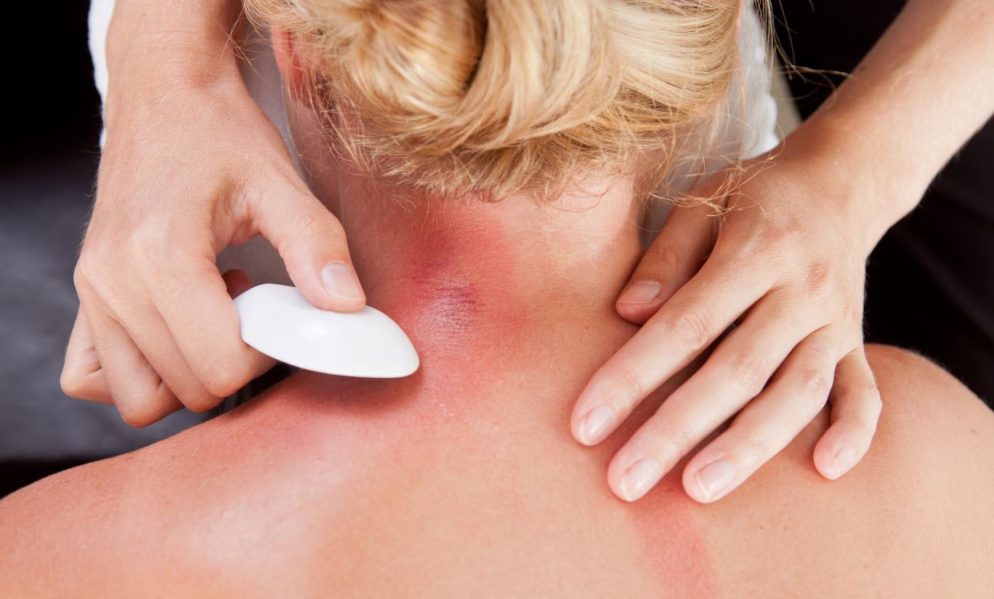What is the benefit of Gua sha? Have you been curious about circular or striped red marks on the skin of people around you? You may have observed the short-term after-effects of Gua sha or cupping.
The related practices of ancient cupping and muscle scraping, also known as “Gua sha”, have recently gained popularity in Western alternative medicine and wellness communities. So popular in fact, that numerous Olympic athletes have been spotted in the games sporting the telltale rashes. Many receive Gua sha for discomfort in the legs, neck, or back.
Here, we will explore the benefit of Gua sha as it relates to musculoskeletal health.
What is Gua sha?
Gua sha therapy is also known as cao gio, khoud lam, and ga sal in different Asian countries [1]. “Gua” refers to uni-directional, instrument-assisted (often a spoon, coin, or buffalo horn) scraping at specific acupuncture points and meridians on the body. “Sha” refers to the rash-like redness associated with the therapy, as blood is brought to the surface of the skin [1].
Gua sha therapy is a 2000-year-old, but still widely-used, noninvasive healing technique in East Asia [1]. A recent study published in Taipei reported that Gua sha therapy was the third most accepted manual therapy for the management of musculoskeletal discomfort, after acupuncture and Chinese tui na therapy [1]. Approximately 25% of the general population in a Hong Kong community receive Gua sha therapy from Complementary and Alternative Medicine practitioners for the management of pain-related conditions [1].
While cupping and Gua sha are different practices, they both work on the principle of stimulating blood flow and microcirculation. They guide “chi” or “qi” energy and circulating nutrients to the areas of the body where they are most needed. They are also meant to stimulate the movement of lymph and the removal of toxins from areas in which they may be stuck.
Finally, Western science is coming around to support these ancient practices as there is a growing body of data to back it up.
Why try Gua sha?
While Gua sha can be used for mood, sleep, skin, and perimenopausal symptoms (among others), one benefit of Gua sha is musculoskeletal support for chronic discomfort. Because we are highlighting musculoskeletal health this month, that will be our focus here, too.
When it comes to discomfort in the joints and body, non-steroidal anti-inflammatory drugs (NSAIDs) are the most common prescription. From 2011 to mid-2017, the FDA received more than 5.4 million reports of prescription drug adverse events, including more than 1 million deaths [2]. Not all of these medicines are medications, of course. It does, however, provide some food for thought: can physical comfort be managed without drugs? Or can drugs be complemented with manual therapy?
Gua sha therapy, as an easy-to-use, noninvasive complementary intervention, has been demonstrated to exert both positive effects on inflammation and discomfort in the lower back [1], neck [3], and joints, along with non-specific, chronic discomfort and tension [4].
What should I expect from a treatment??
Depending on where your discomfort is focused, a Gua sha therapist will choose associated pressure points, lymph nodes, and vasculature to scrape. Don’t be surprised if knee issues send your therapist to your back or buttocks for scraping. The way qi energy moves through the body means everything is interconnected.
Your therapist will likely use both a gentle scraping tool and oil of some sort on the skin. The pressure of each stroke will be increasingly strong and steady and may be uncomfortable at times. However, the treatment shouldn’t be painful. Speak up if this is the case.
You will likely have a slight tenderness to your skin after treatment. The rash, or petechiae, should lighten and disappear in two to five days. Dissimilar to bruises, which are caused by trauma, petechiae occur much closer to the skin’s surface. They should fade faster and feel much less tender.
Gua sha is generally considered safe, with few (if any) risks involved. If you have a blood-clotting disorder or are taking blood-thinning medication, talk to your doctor before scheduling a Gua sha appointment.
References
- https://www.ncbi.nlm.nih.gov/pmc/articles/PMC7535769/
- https://www.drugwatch.com/side-effects/
- https://academic.oup.com/painmedicine/article/12/3/362/1829149
- https://books.google.com/books?hl=en&lr=&id=9lZr746KkmMC&oi=fnd&pg=PP1&dq=Nielsen,+Arya.+Gua+Sha++a+traditional+technique+for+modern+practice.+Elsevier+Health+Sciences,+2014.&ots=hZJsEv05Pj&sig=DkAImSHmCINhFhgz5uRPepjWipc#v=onepage&q=Nielsen%2C%20Arya.%20Gua%20Sha%20%20a%20traditional%20technique%20for%20modern%20practice.%20Elsevier%20Health%20Sciences%2C%202014.&f=false



